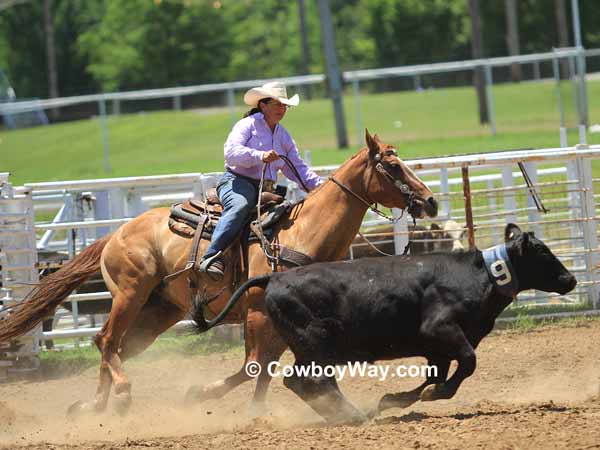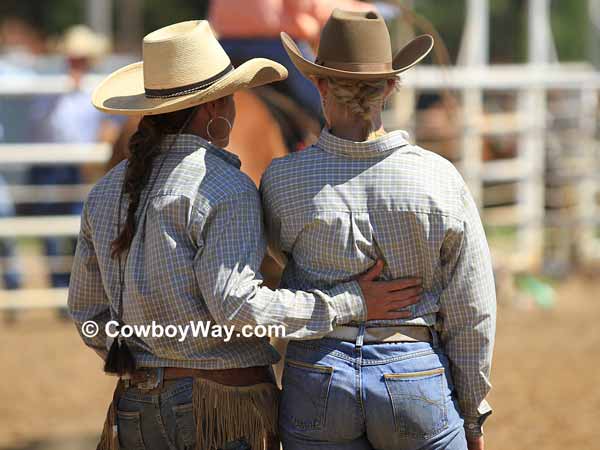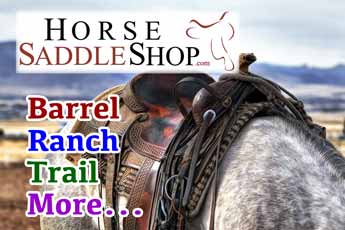Women's Ranch Rodeo Pictures - Page 1 of 2
Below are pictures of cowgirls taken at a women's ranch rodeo.
In a women's ranch rodeo cowgirls compete as teams in events such as sorting, trailer loading, doctoring, tie down (also called mugging), and calf dragging (also called calf branding).
While the number of members per team can vary, four team members is common. You can find more information on women's ranch rodeo a little lower on this page, beneath the pictures.
All photos are copyrighted © and property of CowboyWay.com




All photos are copyrighted © and property of CowboyWay.com
Women's Ranch Rodeo
In women's ranch rodeo cowgirls compete in teams from ranches. Below we have given a description of the events common in women's ranch rodeo, along with some of the rules.
However, while the description and rules provided below are typical, they are for descriptive and general overview purposes only. The events, descriptions, and rules for a women's ranch rodeo you may compete in or watch could be different.
Sorting
Sorting is a timed event that starts with a small group of cattle located at the end of the arena behind a chalk line. Depending on the rules of a particular rodeo, all or most of the cattle will be individually numbered (large, numbered collars are commonly used).
Beginning with a number chosen at random and usually called out by the announcer, the cowgirls must ride their horses to sort one head out of the herd at a time and move it across the chalk line away from the rest of the herd.
Once that calf has been sorted out the cowgirls then sort out the next animal, working in numerical order. If any calf makes its way across the chalk line out of numerical order, or if any calf that has been sorted out returns to the herd, it usually results in a disqualification.
Time stops when a time limit has been reached, or when the team has sorted all their cattle.
Trailer Loading
Trailer loading is a timed event that requires the cowgirl team members to ride their horses to sort a designated calf out of the herd, move it down the arena, and load the lone calf into a trailer.
The trailer is usually parked with one side along the arena fence, with a short wing of portable corral panels at the back of the trailer on the other side. After the cowgirls sort their calf out of the herd they bring it down the arena and turn it up the fence to the back of the trailer. The cowgirls can load the calf into the trailer with their horses or, once they are close to the trailer with the calf, one or all of them can dismount to load the calf on foot. The calf cannot be roped and dragged.
Commonly, the calf is loaded into the front compartment of the trailer, a dividing gate in the trailer is shut and latched, then one of the cowgirls' horses is loaded into a back compartment of the trailer with the end gate required to be shut and latched.
Time typically stops when a time limit has been reached, or when the cowgirls run on foot to a designated area of the arena (usually a small circle made of chalk by the end of the trailer).
Doctoring
Doctoring is a timed event in which a steer is headed (roped around the head) and heeled (roped by the heels), then a chalk mark is placed on its head.
Usually the event begins with the cowgirl team members on their horses at one end of the arena while the steer is released at the opposite end. When a judge gives the signal the cowgirls ride to the steer and one of them will rope its head.
Typically, only a "legal" head catch is allowed. There are three legal head catches: The loop going around both horns, around the neck, or a around a half-head (around one horn and under the neck).
After the steer is headed a different cowgirl ropes its heels. As the two ropers hold the steer the two remaining cowgirl team members dismount and mark the steer on its head with a piece of chalk.
Time stops when a time limit has been reached, or after the steer is marked and the team member signals for time.
Tie Down (Mugging)
The tie down event is a timed event in which a steer is roped and tied down by three legs.
The tie down event usually begins with the cowgirl team members on their horses at one end of the arena while the steer is released at the opposite end. When a judge gives the signal the cowgirls ride to the steer and one of them ropes its head.
Typically, only a "legal" head catch is allowed. There are three legal head catches: The loop going around both horns, around the neck, or around a half-head (around one horn and under the neck).
Next the cowgirls have the option of one of them heeling the steer, or of laying the steer down without heeling it. After the steer is roped by the head and/or the heels, the cowgirls that didn't rope will dismount and lay the steer on its side and tie three legs.
Time stops when a time limit has been reached, or after the steer is tied down and a cowgirl team member signals for time. Typically, the steer must remain tied for a few seconds (6 seconds is common) before the run is officially recognized.
Calf Branding
Calf branding is a timed event in which calves are roped and "branded." (The branding irons are not actually hot, but instead are dipped in chalk.)
The calf branding event begins with a small group of calves in the arena. As one or more teams compete, the other teams will help hold the calves.
The competing team(s) will have one cowgirl on her horse (the roper), while the other three team members are on foot (the ground crew). The roper ropes one calf at a time (legal catches are usually around the head, or by one or two heels) and brings it a short distance to the ground crew.
The ground crew members must lay the calf on its side, remove the rope, then "brand" the calf. Ideally, two calves per team will be roped and branded within the designated time limit (three minutes is common). Teams roping and branding two calves will place higher than teams roping and branding one calf.
Time stops when a time limit has been reached, or when the last calf is roped and the branding iron is placed back into the bucket.
Just An Overview
Remember, while the descriptions and rules provided above are common they are given for descriptive and general overview purposes only. The rules for any particular women's ranch rodeo you may compete in or watch could be different. For more information on women's ranch rodeo, we suggest you visit the Women's Ranch Rodeo Association (WRRA) website.
